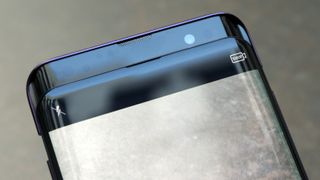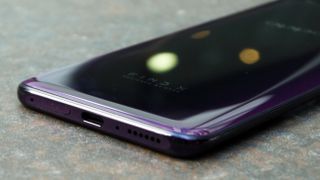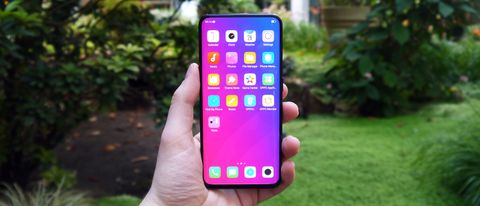Why you can trust TechRadar
Design and display
- 6.4-inch AMOLED display
- 93.8% screen-to-body ratio
- No waterproofing or fingerprint scanner
- No microSD or headphone jack
We’ll kick it off with the good news when it comes to features: the screen Oppo’s used on the Find X is impressive, which is a relief considering how much of it there is.
The AMOLED display is vivid and bright, and with its stupendous 6.4-inch size, is ideal for watching media on the move. Its 1,080 x 2,340 resolution is certainly decent but can occasionally lack clarity when compared to rivals like the HTC U12+, which boasts a 1,440 x 2,880 resolution over 6-inches.

There's two available colors – Bordeaux Red and Glacier Blue – and both look rather striking in person. While the majority of the handset's rear is a glossy black, its bordered by iridescent highlights in your color of choice, and these play with the light as you angle the handset.
The Find X's 'Panoramic Arc' screen features similar curved edges to Samsung’s recent Galaxy flagships (such as the Galaxy S9) and is mirrored on the phone’s dazzling rear. This svelte sheen coupled with the pop-up 3D facial scanning makes the unit feel somewhat alien – more at home in Men in Black than Men in Finance.
The combination of the rounded edges and the near-absent bezels makes for a somewhat surreal experience when holding the phone, although admittedly, this effect is only slightly more pronounced here than when compared to other contemporary all-screen handsets.
The lack of a notch in that display also leads to the Find X's most unique feature. Given the absence of any front-facing cameras, sensors or speakers on the handset’s face, Oppo’s solution is to house these all in a sliding, motorised shelf that automatically extends when it’s needed.














It’s been a while since we’ve seen any such mechanisms in a handset , especially ones which involve automation (the most recent that comes to mind is the Oppo N3), but is it as clunky as it sounds?
Oppo’s word is that the motorized mechanism has a durability rating of over 300,000 uses, which would allow you a little over 400 movements every day for two years (that's more or less the average length of time people hang on to their handsets).
Despite this promise, we can’t help but feel a little sceptical that the whirring motor will be able to maintain its full speed over that lifetime, and it’s not necessarily zippy out of the box, taking just under a second to fully extend.
The sliding drawer also has a tendency to collect pocket lint and dust, which we assume isn't particularly healthy for the handset when it slides back in. When extended, it also feels a little spongey, offering moderate resistance but a little wobble when handled.

All this wouldn’t pose such an issue if Oppo hadn’t doubled-down on 3D facial recognition as the primary security measure for the handset. If there were a fingerprint scanner too, then users could cut down their reliance on this gimmick severely, relegating the sliding shelf to taking photos and selfies.
While the facial recognition itself is just as snappy as its Samsung and Apple equivalents, even sporting an infrared scanner to allow for unlocking in the dark, the speed of the recognition tends to be bottlenecked by the speed of the mechanism itself.
In the case of this bearded, bespectacled reviewer, facial recognition was unsuccessful often enough that we ended up compromising and deactivating it (alongside the tedious passcode). Not an ideal situation, but in our case, turning off our handset's lock-screen security slightly outweighed the frustrating alternatives.

Once we’ve gotten past the beauty and anguish of the Find X’s signature feature, the rest of the handset’s layout is fairly straightforward, with volume and power buttons on either side, and the rest relegated to its base.
Notably missing, however, is any sign of storage expansion options such as a microSD card slot – and there's no 3.5mm headphone jack for that matter, either. Naturally, the top of the phone is unable to support these kinds of features due to its mechanism, and the base of the phone is already crowded.
Another victim of the pop-up camera is any promise of water resistance – something we’ve come to expect in most modern handsets, let alone premium flagships. Again, if there weren’t so many necessary design sacrifices being made for the sake of the sliding shelf, then we’d be a little more forgiving of it.
Battery
- 3,730mAh capacity
- Above-average performance
- VOOC Fast Charge is really fast
Thankfully, Oppo has ditched the micro-USB charging port that it's perplexingly stuck with even up to recent flagships (we’re looking at you again, R15 Pro) and replaced it with the rightful heir to the throne: USB-C.
The company’s VOOC Flash Charge technology is much less silly than the name would imply, allowing for some speedy top-ups, particularly when charging from lower percentages. For instance, we saw the battery rise from 12-87% in just under an hour, although it should be noted that VOOC slows down significantly after it hits the 80s.
We’re happy to say that the big 3,730mAh battery isn’t just for show either, with decent optimisation making it comfortably last a day and half’s usage, and likely even a full second day if you’re not too heavy-handed with power-hungry tasks.

In our PCMark Work battery tests, the Find X scored 8 hours 4 minutes, which beats out the Galaxy S9 at 7 hours 44 minutes, and the HTC U12+ at 6 hours 24 minutes, and doesn’t look too shabby next to the 4,000mAh battery-touting Galaxy Note 9, which scored 8 hours 56 minutes.
While PCMark’s Work test focuses on processor and RAM-intensive activities, the GFXBench tests we ran showed the Find X battery drained much quicker when it was cranking its GPU, so those looking to game on the go may have to be a touch more conservative if they want to hit that second day.
Current page: Design, display and battery
Prev Page Introduction, price and key features Next Page Camera and performance
John joined TechRadar over a decade ago as Staff Writer for Phones, and over the years has built up a vast knowledge of the tech industry. He's interviewed CEOs from some of the world's biggest tech firms, visited their HQs and has appeared on live TV and radio, including Sky News, BBC News, BBC World News, Al Jazeera, LBC and BBC Radio 4. Originally specializing in phones, tablets and wearables, John is now TechRadar's resident automotive expert, reviewing the latest and greatest EVs and PHEVs on the market. John also looks after the day-to-day running of the site.

The next HomePod could be more like a soundbar according to this Apple patent – and it hints at fixing the HomePod 2’s biggest issue

Adobe's next big project is an AI that can upscale low-res video to 8x its original quality

Over a billion users could be at risk from keyboard logging app security flaw
